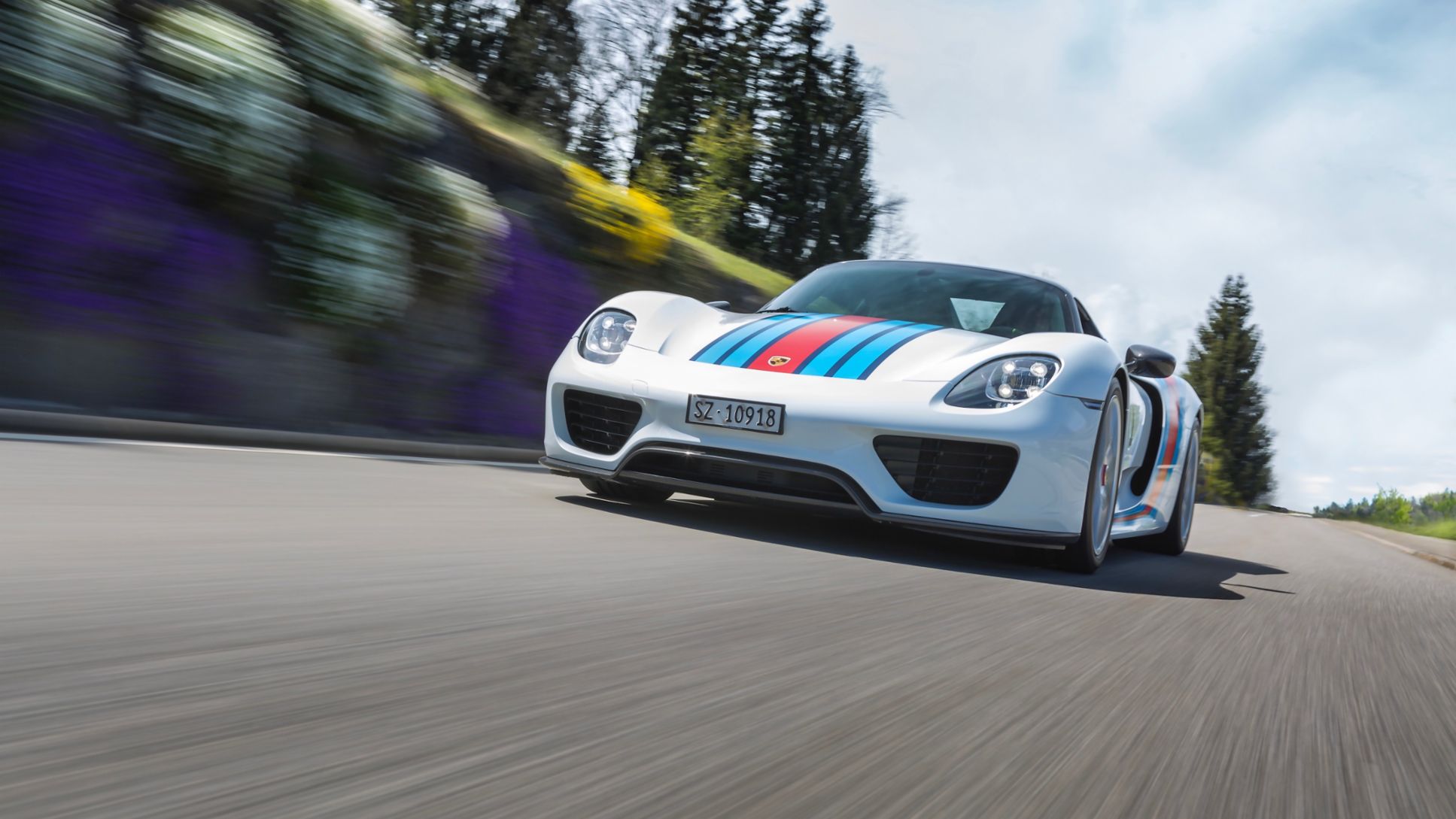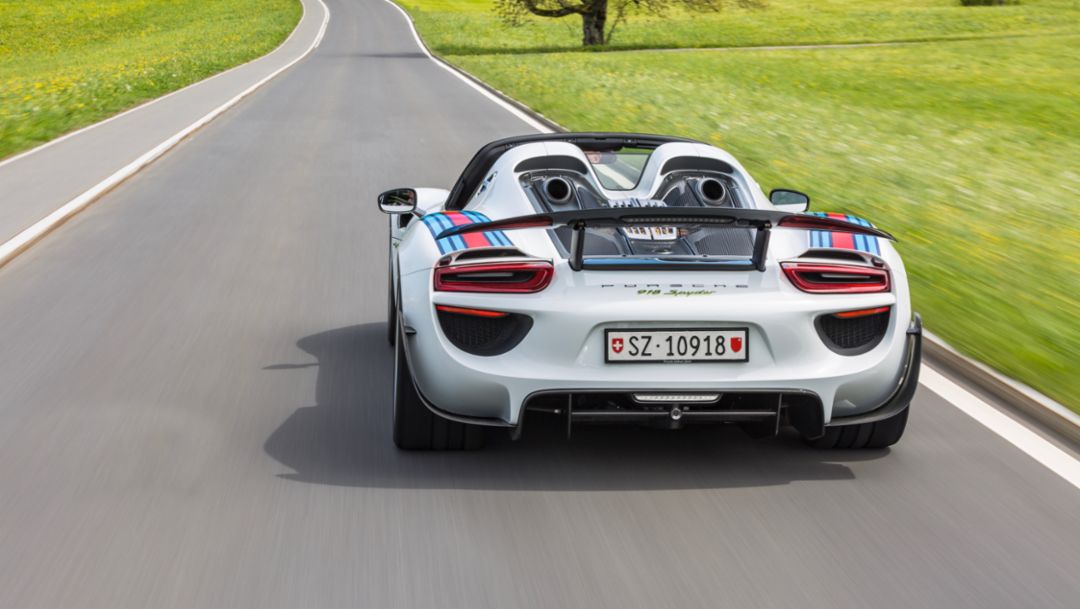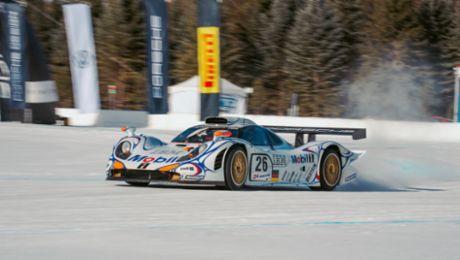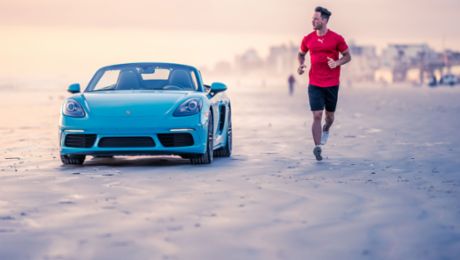It’s not often you see someone in their mid-sixties jump out of a Porsche Cayenne so youthfully. His attire – jeans, waistcoat, a checked shirt and John Lennon-style sunglasses – take at least two decades off him. This man’s appearance speaks volumes about his continued zest for life. Benno Oertig lives for two things dear to his heart: his daughter Marina and two sleek sports cars in the legendary Martini design.
We are meeting in Freienbach in the Swiss canton of Schwyz. Oertig opens the gate to the hall and reveals his hideaway. Sparkling grey floors and snow-white walls adorned with large-scale triptychs of his racing cars. “On the right there at the back, we will have a workshop area and some lounge furniture”, explains Oertig, pointing to the, as yet, bare corner. For him, it is the perfect atmosphere in which to prepare for the next race or to reminisce about the last circuit laps with his 911 GT3 RS. Or simply to enjoy the sweeping lines of one of his Porsche 918 Spyders. Oertig has been a car guy ever since he was a youngster, so much so that he applied for his first racing licence on his
18th birthday. “Me in a Renault R8 Gordini against the NSU TT”, he recalls. At the age of 25, however, he hung up his helmet and gloves and sold them together with the car, investing the proceeds – “50,000 francs, that was a lot of money at the time” – in his first company.
It was goodbye to his racing career; from this point on, finances and family became the dominant features of his life, taking him abroad many times. At the height of his career, he was involved in the management of 63 companies in no less than 24 European countries. There was no time left for fast laps, but his heart still beat for the cars. “In 1986, I bought my first Porsche, a 3.2 litre 911 Carrera with 231 hp. At that time, it was the most powerful Porsche in the range after the Turbo”, says Oertig. And the starting point for a lifelong passion.
Enduring love for the brand
From that moment on, Benno Oertig never missed a 911 generation – his garage always housed at least one Porsche, at times even two or three: “The 964 model line was a revelation – all-wheel drive at last!” He even caught up on every 911 that he had missed in the years prior to 1986, such as the Turbo and Carrera Cabriolet from the G series. Currently, his garage is home to various vehicles including a 2015 Targa 4, a 2014 GT3 and the white Martini GT3 RS from 2016. And, the jewel in the crown, the 918 Spyder: serial number 71 out of a total of 918 units produced. Its weight is reduced by around 41 kilograms thanks to the optional Weissach package with lighter brake discs, ceramic wheel bearings, titanium bolts and carbon-fibre-reinforced plastic instead of aluminium in the body and interior.
“This is the future, a revolution”, says Oertig about the combined plug-in hybrid drive with a 887-hp high-speed V8 and a 129-hp and 156-hp electric motor on the front and rear axle respectively. “This car is so effortlessly manageable, so efficient.” He enthuses further, saying that the variable torque distribution to all four wheels ensures incredible driving precision and that a current 911 GT3 is significantly more demanding in terms of handling.
He describes the 918 Spyder as the dawning of a new era, saying that he loves to be there right from the start of a new chapter. In the run-up to the market launch of the limited Porsche flagship model, Oertig also had professional ties to Porsche.
“Just a few laps in the passenger seat on the in-house test track in Weissach were enough to know that this is the one”, gushes Oertig. He wanted a good number, of course, and got in there early, scooping the 71st 918 Spyder. The Martini livery – in the form of a decal rather than painted on for weight reasons – was a must, as a reminder of his racing days. The only thing that is “unfortunately” missing is the brand logo, due to the restrictions on advertising alcohol in public.
The roadster has such superior driving characteristics that, where possible, Oertig says that he drives it only on the race track or during the regular Porsche Spyder Club tours. “The ceramic brakes grip so sharply that if a driver behind me wasn’t paying attention, they could be in trouble”, says Oertig. Even on the track, it can sometimes get dicey. Every time he put his foot on the pedal “in the hairpin at the back of Hockenheim”, he hoped that his competitors behind him were also ready to brake: “You can be careful as you want, but the others have to be looking too.”
Sometimes the two-seater attracts more attention than he would like; even in the business world, he says he prefers to stay in the background. “My parents always used to have their cars blessed”, he says, “and this is important to me too.” Leaving the 918 Spyder parked on the square in front of Einsiedeln Abbey for no more than a couple of minutes, he returned with the clergyman to see “at least three hundred people” surrounding the spectacular roadster. “It’s hard to believe, but we’ve also been forced to slow down on the motorway before because someone wanted to take a photo of the car”, says Oertig.
Finally time to devote to his passion
With the partial withdrawal from professional life, Oertig now has more time for his cars: “I can now spend the best time of my life with them – it’s perfect.” Not that he has renounced the thrill of business life. He continues to work in the private equity and real estate sector, “but for myself, not for a company anymore”. He devotes at least half of the month to motorsport again, for example, driving a Cayman GT4 Clubsport in the Porsche Sports Cup Suisse: “It was like going back to my roots, all the colleagues, against whom I competed as a young driver are either back again or still there”, enthuses Oertig. The Porsche Sports Cup Suisse provides a delightful contrast to his 918 Spyder. The car challenges his driving qualities, as mistakes cannot simply be smoothed away again with superior performance: “In the Cayman GT4, you’ve always got to stay on the ball and remain focused at all times.”
Paul Ricard, Imola, Hockenheim, Nürburgring – what with travelling there and training, Oertig spends around 15 days per month on the race track during the season: “The adrenaline rush keeps me alive. On the tarmac, you remember how much you need adrenaline – in business life you too often forget.” Oertig is already looking forward to his 2018 911 GT3, with Porsche Doppelkupplung (PDK) of course. It “took far too long for Porsche to finally offer an automatic transmission in the 964”.
Why his decades of loyalty to Porsche, what is the attraction for him? “Honestly? The reliability”, says Oertig. He’s hardly ever had any problems with a Porsche; his cars have always started in the morning without hesitation: “Porsche is a German marvel, not an Italian diva.”
Info
This text originally appeared in the Porsche customer magazine Christophorus, issue Switzerland 383
Text: Andreas Faust
Photos: Ian G. C. White
Consumption data
Cayenne models: Fuel consumption combined 11.9 – 9.0 l/100 km; CO2 emissions 272 – 205 g/km
911 GT3 RS: Fuel consumption combined 12.7 l/100 km; CO2 emissions 296 g/km
911 GT3: Fuel consumption combined 12.9 – 12.7 l/100 km; CO2 emissions 290 – 288 g/km
911 Targa 4: Fuel consumption combined 8.9 – 7.9 l/100 km; CO2 emissions 206 – 182 g/km

.jpg/jcr:content/PORSCHE%20SPYDER%20918%20000%20(2).jpg)




